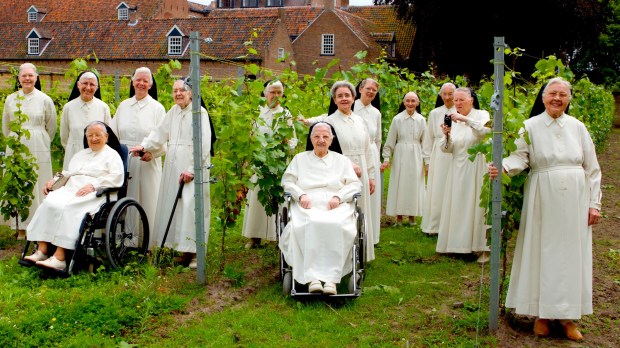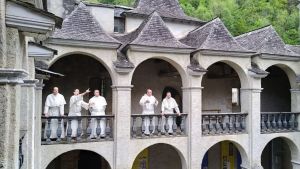The Norbertine nuns of Sint-Catharinadal (“Valley of St. Catherine”) Monastery in Oosterhout are one of the oldest congregations in the Kingdom of the Netherlands, having been in existence for nearly 750 years. They have had a turbulent history, especially during the Protestant Reformation and French rule after Napoleon’s conquest, when, despite freedom of religion, monastic life was considered useless and contrary to freedom.
Through it all, the Norbertines preserved not only their community, but also the monastery buildings and the land around them. This was in large part thanks to the protection of members of the royal court, to whom several sisters were related. When possible, the Norbertine nuns cultivated the fields and ran the farm so they could be self-sufficient. This is still the case today. Only the “repertoire” of crops and products has changed. Today, they mainly produce wine.
Why wine?
“It has biblical connotations and refers to Jesus. And frankly, the sisters like it, too,” explains Sister Mary Magdalene, prioress of the Sint-Catharinadal monastery, located in the Brabant region of southern Holland. The Norbertine nuns had initially considered growing hops on the monastery’s vast grounds. However, they decided that beer production was less in keeping with the image of a women’s monastery, and began producing wine instead in May 2015.
This commercial activity of the nuns — running a vineyard, winery, and monastery store — exists for one simple reason: to maintain a healthy financial basis for the future. In a country where there is a certain estrangement between society and the Church, and relatively little material support from the community, the nuns are trying to make a living from their own labor.
White, pink and sparkling
A bottle of white Norbertus (the wine’s name, in honor of the order’s founder) or pink Ricvera (named after the first Norbertine nun) costs 14.50 euros (about 15.75 dollars). But these are not the only types of wine you can taste made by the sisters’ hands. There’s also Augustinus, a Chardonnay aged in wooden barrels, named after the Father of the Church, whose monastic rule the Norbertine order follows, and other varieties with names referencing the history and culture of the community.
A vineyard the size of 10 football fields
The sisters grow their grapes in fields where for about 365 yearstheir order had grazed cows and grown corn. As a result, the soil today is properly prepared for growing grapes. The grape varieties planted include Chardonnay, Pinot Gris, Pinot Blanc, Auxerrois (for white wines), Pinot Noir, and Gamay (for light rosé, as in Provence). The vineyard at the Norbertine estate is 18.5 acres (about 10 football fields). On average, the sisters produce 40,000 bottles of wine from their annual fruit harvest. In 2019 they announced an initiative to further expand the vineyard, which they are currently implementing.
Overproduction
Last year’s hot weather put the nuns in a rather difficult situation. The grape harvest was so abundant that they produced 64,000 bottles of wine … which they were unable to sell.
The nuns had already been stuck with a surplus once before in 2020 during the pandemic, when Dutch airline KLM withdrew an order for 20,000 bottles. At the time, the Norbertines were helped by the local organization Breda Maakt Mij Blij (“Breda makes me happy”), which stepped up to the plate again this year. Residents of Breda (a city in the southern Netherlands), through this website, help local farmers and producers who are having trouble selling their products.
“It’s a tall order,” said Thibaud van der Steen, a spokesman for the helpful website, to DutchNews. “It was just too hot and sunny last year. It sounds good but now they have 64,000 bottles to sell.” Meanwhile, the Norbertine sisters see the increase in wine stocks as a godsend. “It will alleviate our money worries, if they sell, that is,” said Sister Mary Magdalene.
The harvest is great, the laborers … plenty!
The monastery in Oosterhout is inhabited by 10 sisters, so the question arises, “How do they manage to harvest grapes from an area of 10 football fields and then bottle enough wine to fill an Olympic swimming pool (about 30 million liters)?” This is where the wonderful people of the area come to the rescue again! They are helped by more than 130 volunteers including people with intellectual disabilities.
They take care of the vineyard all year round by pruning, weeding, picking, and labeling. The harvest in autumn is done by hand; the bunches of grapes are cut under the guidance of experts. The fruit is then pressed in the monastery’s winery, and the fermentation process begins in oak barrels and stainless steel tanks. In the spring, the wine is finished and then bottled by an outside company.
You cannot not live on wine alone
A monastery amidst the vines bears fruit not only materially, but also spiritually. It is in this atmosphere of the Lord’s biblical vineyard that one can stay at the House of Learning and Inspiration, to which the sisters invite all those seeking reflection and personal growth, or simply peace and quiet in the rhythm of the monastery. The source of inspiration and the center of the spirituality of this place is “working in the vineyard!”
Through this task and the realization that they are stewards of a cultural and spiritual heritage, the sisters connect with others to serve God and people today. They do this with the attentiveness and silence that have characterized the life of Sint-Catharinadal for more than seven centuries. And they possess something that is hard to find in today’s secular culture: They live like true disciples of Jesus, in the warm, friendly atmosphere of His light.
Responding to spiritual needs
“The boundary between faith, meaning, and spirituality is less sharply perceived nowadays than in the past. Taking a moment to reflect on these matters may result in increasing interest, also among those who no longer feel (entirely) at home in the traditional Church. The (monastery’s) Learning and Inspiration House seeks to meet a social need in this area. In addition, it offers those interested a way to learn about monastic life,” the Norbertine nuns write on their website.
As part of this spiritual “offering,” the nuns work with experienced partners to serve people through retreats, days of recollection, meetings with the sisters, or simply overnight stays at the Guest House.
The beautifully restored monastery buildings have the status of national monuments and exude tranquility, simplicity and beauty. It’s a uniquely inspiring environment in which to come together with God, with yourself, with others.




